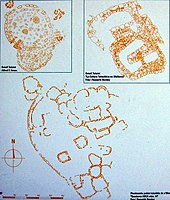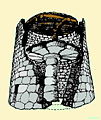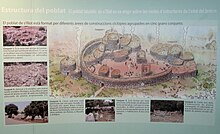Talaiotic settlement of S'Illot
| Talaiotic settlement of S'Illot Poblat talaiotic de s'Illot | ||
|---|---|---|
|
Poblat talaiotic de s'Illot |
||
|
Location in Mallorca |
||
| Coordinates | 39 ° 34'7 " N , 3 ° 22'20" E | |
| place | Sant Llorenç des Cardassar , Balearic Islands , Spain | |
| Emergence | 1100 to 123 BC Chr. | |
| height | 8 m | |
The talaiotic settlement of S'Illot ( Mallorcan Poblat talaiòtic de s'Illot ) is an archaeological excavation site of a settlement on the Spanish Balearic island of Mallorca that is part of the Bronze Age Talaiot culture (also Talayot culture) . It is located on the east coast of the island in the municipality of Sant Llorenç des Cardassar in the region ( comarca ) Llevant . The exact age of the settlement is not known, the oldest finds date from around 1100 BC. Chr.
location
The place S'Illot is a coastal settlement on the Cala Moreia , a small eastern Mallorcan bay, and is located between the settlements of Sa Coma in the north and Cala Morlanda on the bay of the same name in the south of Cala Morlanda . The three settlements by the sea, designed as tourist sites , merge into one another without any visible border. S'Illot is divided by the municipal boundary at the Torrent de Ca n'Amer , a torrent , between the municipalities of Sant Llorenç des Cardassar and Manacor and administered separately by both.
The prehistoric remains of the Talaiotic settlement of S'Illot are located about 100 meters northeast of the Torrent de Ca n'Amer , within the settlement part of S'Illot that belongs to Sant Llorenç des Cardassar. The excavation site, which is completely enclosed by the buildings of the tourist site, has an area of around 8000 m² and is 100 meters away from the coast of Cala Moreia . The area is limited by the streets Carrer Llebeig , Carrer Gregal and Carrer Rosa dels Vents . The road that connects S'Illot with the interior of the island towards Son Carrió and the coastal road MA-4023, the unnamed MA-4021, ends directly at the excavation site. The area is not fenced and therefore freely accessible. Adjacent to the west in Carrer de Llebeig is a visitor center where information on the history of the Talaiotic village is provided.
description
The Talaiotic settlement of S'Illot, built on a flat surface, is bounded on the west side by a Cyclops wall with a semicircular floor plan. It may have surrounded the entire complex in the past, but this has not yet been clarified. Individual buildings in the south of the settlement seem to have been integrated into this wall. The remaining wall remains consist of large, unjoined stones facing the outside, which were placed vertically, a gap filled with gravel and medium-sized, horizontally lying stones to the interior of the settlement.
One of the three towers of the settlement, called Talaiot , is located northwest of the wall ring. It has a round shape and a southern extension that connects the tower with the outside of the perimeter wall. The large stone wall ends at the height of this talaiot, so that the north and west sides of the talaiotic settlement are open today. Only bushes and small trees hinder access to the remains of the settlement from these sides. On the north side, the municipality of Sant Llorenç des Cardassar has put up an information board with a map.
The center of the prehistoric complex was formed by the main square talaiot, which, with its disorderly adjoining extensions, stands on the northeastern area of the excavation site. It was uncovered between 1960 and 1970 by researchers at the Philipps University of Marburg . In addition to the smaller, often square extensions with rounded ends, the central monument has an extension to the southeast by a kidney-shaped chamber, under which an underground passage leads to a freshwater lake. The original features of the main talaiot have not been preserved due to modifications and additions in later epochs.
The third tower of the Talaiotic settlement stands at the southern end of the excavation site. It has a circular floor plan with a western entrance from the interior of the settlement. Like the central building, this talaiot is surrounded by several square extensions. Some of the extensions have the peculiarity that they seem to continue the western enclosure wall. In some of these rooms, however, the arrangement of the entrance areas, which face south or west towards the outside area of the settlement, speaks against a protective function towards the outside. It is possible that these buildings were located in the sea on the coast, which is 100 meters away today, as the area of S'Illot was marshland in the past .
- Structural remains of the Talaiotic settlement
The foundation walls of two sanctuaries have been preserved between the southern talaiot, the central monument and the western enclosure wall. Both have a horseshoe-shaped floor plan, that is, a straight side on which the respective entrance is located is opposite a semicircular side. The two sanctuaries of the settlement of S'Illot face each other somewhat offset with the straight sides. The conviction that these structures were sanctuaries, one inferred from similar structures in other Talaiotic settlements on the island, in which cult objects and remains of sacrificial animals or ritual meals were found. No such evidence was found in S'Illot.
history
Period of the Talaiotic
The age of the talaiotic in Mallorca reached from about 1300 BC. Until the Roman conquest of the island in 123 BC. The Talaiot culture is a megalithic culture between the end of the Bronze Age and the beginning of the Iron Age , characterized by towers and other buildings in large stone construction. The name talaiot ( Catalan ) and talayot ( Castilian ) is derived from the Catalan word talaia for "observation and watchtower", which has its origins in the Arabic atalaji for "guard". Similar structures were built in Menorca , Corsica , Sardinia and Pantelleria during this period . The talayotic is divided into four sections, the first two and the last two of these time sections differing less from each other.
The time of Talaiotic I , beginning around 1300 BC. BC, is characterized by the emergence of underground tombs and individual towers in the aforementioned megalithic construction, the so-called Cyclops technique . In Talaiotic II , from approx. 1000 BC. BC, walled enclosures were added to the settlements. From these two phases of the first period of the Talaiot culture finds from common pottery, burial pottery, bronze weapons and tools and worked bones are known.
In the soil layers that were built in the years after 800 BC In addition to ceramics and figures made of bronze, objects made of lead and iron were also found . Various finds suggest a beginning trade with the Carthaginians , which began around 654 BC. Founded a trading post in Ibiza . The settlements in this section of Talaiotic III received additions with a rectangular floor plan as well as hypostylos halls (pillared halls) and excavations reveals a bull cult with cremation .
In Talaiotic IV from around 500 BC Chr. One went to the form of burial in fetus position (in lime ). Sanctuaries were built structurally and replicas of Carthaginian / Phoenician and Roman forms of ceramics emerged , which is known as acculturation . The offensive armament ( swords , knives , lance tips ) and the variety of tools increased in importance. The influence of other Mediterranean civilizations led to a gradual change in the local culture, which is evident not only from the household appliances found at the time, but also from the spiritual and artistic works, such as hero and warrior icons (small statues known under the name "Mars Balearicus").
- Reconstructions of a Talaiot settlement
Classification of the Talaiotic settlement of S'Illot
On the basis of C-14 analyzes of charred wood splinters from the lower soil layers, the earliest finds of the prehistoric settlement of S'Illot could be dated around 1100 BC. To be dated. Wall sections found under the main Talaiot with an absidal ground plan, which are probably remnants of Naviformes , suggest a pre-Talaiotic settlement of the area of the settlement. This before 1300 BC Buildings erected in BC formed the foundations for the central monument and its extensions. The two round talaiots are attributed to the same period in which the square main talaiot was created.
The surrounding wall was erected at a later time. The horseshoe-shaped sanctuaries are also more recent. Individual buildings were subsequently added to the existing development, other rooms, such as the square talaiot in the center, were converted or expanded. From the extent of the settlement known today, the population is estimated at around 200 people. The Talaiot settlement was inhabited, with the exception of a settlement gap after the Roman conquest of Mallorca in 123 BC. BC, also in the late Roman period up to and including the Islamic epoch .
The inhabitants of the settlement lived mainly from agriculture and animal husbandry. In addition, fishing, mollusc collection and hunting were carried out. Game that could be hunted back then were wild bird species , red deer , fallow deer , wild boar , wild cats and monk seals . This is attested by the excavation results. Bones of sheep , goats , pigs and cattle point to cattle breeding , to agricultural activity the finding of hand mills , mortars and pestles .
The classification of the five talaiots and one burial mound, which are scattered on a territory about two kilometers around the talaiotic settlement of S'Illot, is still unclear. The Talaiots are those of Na Pol , Na Gatera , Ca n'Amer , sa Gruta and the Talaiot on the coast north of Cala Morlanda , which are arranged in an arc around S'Illot and are approximately the same distance from each other . An observation or defense function for the settlement would be possible.
- Talaiotic buildings in the area
In terms of size, the talaiotic settlement of S'Illot is one of the most important settlements of the Talaiot culture in the east of Mallorca. If one assumes overseas connections in this epoch, it may also have played a special role in trade and cultural exchange with related cultures on the other islands of the western Mediterranean east of Mallorca.
literature
- Hans-Peter Uerpmann : The animal bone finds from the Talayot settlement of S'Illot (San Lorenzo, Mallorca). Munich 1971.
- Otto-Herman Frey , Guillermo Rosselló Bordoy : A talayot settlement near S'Illot (San Lorenzo, Mallorca). In: Madrider Mitteilungen 5, 1964, pp. 55-72 and 9, 1968, pp. 63-75. ISSN 0418-9744
Individual evidence
- ↑ Gabriel Pons i Homar: Archaeological Paths S'Illot - Sa Coma. Ajuntament de Sant Llorenç des Cardassar, Delegació de Turisme ( Memento of the original dated August 12, 2012 in the Internet Archive ) Info: The archive link was inserted automatically and has not yet been checked. Please check the original and archive link according to the instructions and then remove this notice. (PDF file; 455 kB).
- ^ Heide Wetzel-Zollmann, Wolfgang Wetzel: Mallorca - A foray through the 6,000-year history of the Mediterranean island , Verlag Herder, page 14, ISBN 3-451-22311-2
- ↑ Jaume Alzina Mestre, Miquel Pastor Tous, Jaume Sureda Negre: The Talayot Ses Païsses . Ajuntament d'Artà. ISBN 84-606-2221-5
- ↑ Gabriel Pons i Homar: Archaeological excursions through Mallorca. Consell de Mallorca, Department de Cultura.

















